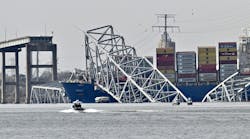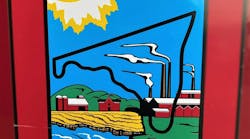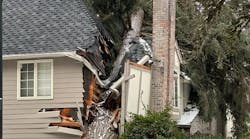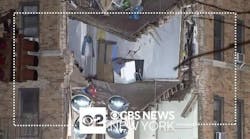On Oct. 30, 2003, the Tropicana Casino in Atlantic City, NJ, suffered a catastrophic collapse at the parking deck that was under construction. The 12-story facility suffered a major failure while the top floor was being completed, resulting in a progressive collapse that sent tons of debris and raw concrete to the floors below.
By the time the dust had settled, first-arriving units were faced with a daunting rescue scene: Multiple floors had suffered massive damage, resulting in cantilevered floors being supported by rebar and wire, dozens of workers injured and four workers losing their lives (photo 1). Almost immediately upon arrival of the chief officers, Command had requested a response from local and state technical rescue teams.
It became apparent early into the operation that this incident would require an enormous amount of support. The collapse area on each floor was approximately the length of three football fields and over 100 feet wide. Additionally, the collapse resulted in supports and columns that swayed precariously over the collapse scene. Any rescue attempt would have to consider the potential collapse of these free-standing hazards (photo 2).
While rescue teams were summoned to respond, a six-sided size-up approach was initiated. Locations for potential victims and identification of shoring locations were identified, engineers and construction/rescue experts devised an offensive plan for efficient rescue and removal of victims, while stabilization and shoring concerns were identified and implemented to keep surrounding exposures safe from further damage.
Approximately 30 hours after the initial alarm, all workers and on-scene personnel were accounted for, and all rescues and recoveries were completed. USAR teams and rescue resources were demobilized and cleared from the incident.
Lessons learned
Considering the complexity and the dynamics of the incident, a few points were raised for consideration and remediation:
- Consider the ENTIRE size of the incident Hot Zone: Responders were faced with a large footprint to search, and the area expanded beyond the original structure. Due to the size of the initial collapse building, exposed buildings and occupancies had to be identified for damage and support/stabilization (photo 3, 4). Resources were assigned areas to search and identify for further support, all while crews from rescue teams converged in the initial collapse area.
- Operations in large buildings require large amounts of resources: Technical rescue specialists provide the expertise and skills needed to safely mitigate the incident. The key to this success relies in the amount of personnel needed to put the necessary equipment into place (photo 5).
- Consider the magnitude of the incident in question: Multiple stories will require significant amounts of equipment placed into position to secure the building. In this instance, there was a large amount of shoring equipment already on site that was in use by the construction staff while the building was being built. Furthermore, the “experts” in placing this equipment into position were already on scene. Who better to place this equipment? The construction staff was assigned as part of the rescue squads entering the structure, and worked jointly to stabilize and support the ongoing rescue mission. Additionally, the duration of the rescue resulted in multiple operational periods. Personnel will be needed for the next operational period and must be notified as to when and where to respond for the incident.
- Advanced equipment needs to be addressed early in the incident: The magnitude of the incident resulted in the need for equipment to search various areas and voids, and to support a tremendous amount of weight from the structure. Specific types of shoring and stabilization equipment needed to be mobilized early, along with state-of-the-art search equipment and updated technology with staff to provide the expertise to utilize it. One of these requests included the K9 search component from the responding USAR team (photo 6). The safety and care of this vital search resource must be addressed as well throughout the operation.
- Heavy equipment may be requested at a scene this size for various usage: Overhead views of the area can be provided, large amounts of shoring and stabilization materials can be lifted into place for responders to use much faster than manually carrying it up to the area in question, and the heavy equipment can assist in stabilizing loads or removing hazardous debris that may be impinging on the safety of the rescuers operating below (photo 7).
- Patient care needs to begin as soon as possible within the Hot Zone: The location of the victim, along with the limited access in the void area, will limit personnel to access the victim in the early stages; therefore, the people who would provide the rescue must have some type of emergency medical training. Entrants performing the rescue should be able to provide treatment and packaging for safe removal of the injured victim from any rescue situation. Secondly, heavily entrapped victims will require advanced life support skills that are beyond the capabilities of most rescue specialists. The removal of debris from around the victim must be supervised by a medical specialist (doctor, trauma nurse, paramedic, etc.) who can treat the victim as they are freed from the entrapment. It is a natural reaction for a responder to want to remove a victim rapidly from their situation, but that has the potential to make things worse without the right treatment in place prior to removal.
- Assign a safety officer at every incident: The scene of a collapse poses significant hazards that need to be identified and abated. A safety officer must be able to identify and correct safety hazards that can lead to injury for both victim and rescuer (photo 8). A scene of this magnitude would require more than one person to continually survey the scene. As such, the safety officer should have assistant safety officers who can cover these areas and report hazards to the safety officer. Additionally, NFPA 1670 (2017): Operations and Training for Technical Search and Rescue Incidents CLEARLY states in section 4.5.2, “the incident commander shall assign a member to fulfill the duties of a safety officer …” with the knowledge, skills and abilities to identify and correct safety issues within the operation. To not have one watching over the incident can be a recipe for disaster.
In sum
Building collapses can prove dangerous and unforgiving to both occupant and rescuer. Granted, there may be incidents that do not result in immediate and vital actions to save lives on every call; the more serious incidents will require long-term needs and logistical support to see them to their conclusion. It is imperative that we stay vigilant, trained and ready in anticipation for anything that we are summoned to handle. Staying ready keeps responders safe and provides the best service for the customers whom we are sworn to protect.
Until next time, stay focused and stay safe.






